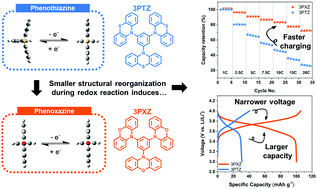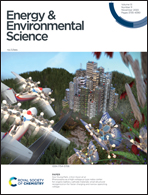Phenoxazine as a high-voltage p-type redox center for organic battery cathode materials: small structural reorganization for faster charging and narrow operating voltage†
Abstract
Although organic p-type cathode materials with high redox potential (>3.5 V vs. Li/Li+) are sustainable alternatives to transition metal oxide cathodes for lithium-ion batteries, only a limited number of these materials have been investigated to date. Therefore, the discovery of new p-type redox centers is essential for further development of successful organic cathodes. Herein, we report phenoxazine (PXZ) as a new p-type redox center for high-voltage cathode materials. Negligible structural reorganization of this PXZ center facilitates a kinetically faster electrochemical pathway, leading to a narrow voltage plateau, full utilization of the capacity, and superior rate capability in a new PXZ-based cathode material, PXZ trimer (3PXZ). The 3PXZ cathode delivered a specific capacity of 112 mA h g−1 at 1C with a high average discharge voltage of 3.7 V vs. Li/Li+ in a Li-organic cell; moreover, even at a high rate of 20C, 73% capacity retention (76 mA h g−1) was achieved. In addition, a 3PXZ composite with mesoporous carbon CMK-3 exhibited a capacity of 100 mA h g−1 with high stability, losing only 0.044% capacity per cycle over 500 cycles at 5C. As 3PXZ outperforms most reported p-type cathodes in terms of both rate capability and stability, we suggest the adoption of the PXZ unit as a novel and promising redox center for high-performance and sustainable energy storage systems.

- This article is part of the themed collection: Energy & Environmental Science Cover Art


 Please wait while we load your content...
Please wait while we load your content...